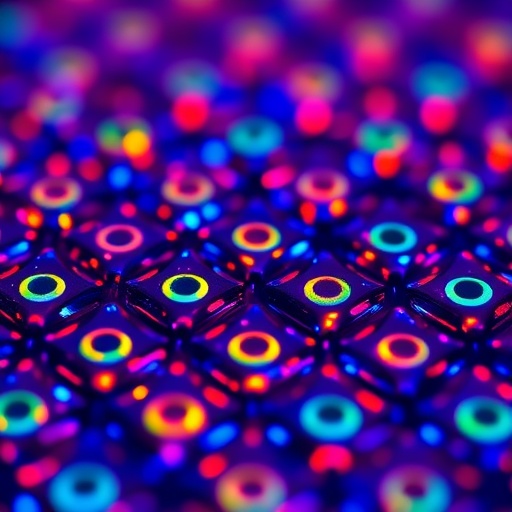The recent publication by Tian, Sun, Chen, and colleagues in Light: Science & Applications heralds a groundbreaking exploration into the triboluminescence phenomenon of metal halide perovskite films. This study, published on November 6, 2025, delves deeply into the interaction of mechanical stress and luminescent properties in these emerging semiconducting materials, revealing new dimensions of their optoelectronic behavior and potential technological applications.
Triboluminescence, the emission of light resulting from the mechanical action of rubbing, striking, or fracturing materials, has traditionally been a niche area focused mostly on inorganic crystals and some organic compounds. This research thrusts metal halide perovskite films into the spotlight as promising candidates for this phenomenon, thereby expanding the understanding of their fundamental properties beyond photoluminescence and electroluminescence. The work bridges the gap between material science and optical physics by demonstrating that perovskite films can emit light when subjected to mechanical stimuli, illuminating new scientific possibilities.
Metal halide perovskites have been widely celebrated for their efficacy in solar cells, LEDs, and photodetectors due to their exceptional charge carrier mobility, tunable bandgap, and ease of fabrication. However, triboluminescence in these materials had not been adequately characterized prior to this study. The researchers utilized a meticulously designed experimental setup capable of applying controlled mechanical force to the perovskite films, capturing the resulting emission spectra with high temporal and spatial resolution. This rigorous methodology allowed them to observe and analyze subtle luminescent behaviors triggered by mechanical perturbations.
The triboluminescent light emission in metal halide perovskite films was found to be strongly dependent on the structural integrity and phase of the crystals. The material’s crystalline lattice and its defect states emerged as critical determinants for the intensity and wavelength distribution of the emitted light. Crucially, the team demonstrated that altering processing conditions to modulate the film’s morphology could fine-tune the triboluminescent properties. This insight has profound implications for designing mechanically responsive optoelectronic devices.
An intriguing finding reported by the authors is the role of lattice distortions induced by mechanical stress in activating specific electronic transitions that produce visible light. They provide theoretical and experimental evidence linking strain-induced changes in the perovskite crystal field with light emission. These observations suggest a new mechanism of mechanoluminescence distinct from conventional photophysical processes. The discovery opens avenues to engineer perovskite materials with tailored triboluminescent capabilities through strain engineering.
In addition to fundamental insights, the study explores potential applications of triboluminescent perovskite films. The ability to emit light under mechanical triggers could be exploited in stress sensors, mechanical damage detectors, and interactive optoelectronic devices that respond physically to external forces. For example, wearable technologies might integrate these films to provide real-time visual feedback on pressure or deformation, enabling new modes of human-machine interaction.
The research team also addresses key challenges related to the stability and longevity of triboluminescent perovskite films. Given that metal halide perovskites often suffer from environmental degradation and ion migration under operational stresses, the study investigates encapsulation strategies and compositional engineering that enhance material robustness without compromising triboluminescent performance. These findings emphasize the importance of developing durable triboluminescent materials for practical deployment.
Methodologically, the authors employed advanced microscopy techniques and spectroscopy coupled with mechanical testing to dissect the spatial distribution of luminescence within the films. This comprehensive approach revealed localized sites of intense emission correlating with microcracks and grain boundaries, implicating nanoscale heterogeneities as essential contributors to triboluminescence. The integration of imaging and mechanical characterization thus presents a powerful toolkit for future mechanoluminescence research.
Moreover, the theoretical framework underpinning the study incorporates quantum mechanical modeling combined with continuum mechanics to elucidate the coupling between mechanical deformation and electronic excitations in perovskites. This interdisciplinary modeling sheds light on the energy transfer pathways and provides predictive capability for optimizing triboluminescent responses through material design. The synergy of experiment and theory showcases the maturation of triboluminescence as a field.
The implications of this research transcend laboratory curiosities. As perovskite optoelectronics continue to advance, integrating triboluminescent properties promises multifunctional platforms that combine energy harvesting, sensing, and display capabilities. This multifaceted functionality aligns perfectly with the modern demand for smart, adaptive materials in consumer electronics, health monitoring, and structural health diagnostics. The work stands at the frontier of sustainable, responsive materials development.
Importantly, the authors highlight the environmental impact considerations of deploying perovskite films in triboluminescent devices. By linking material innovation with green chemistry principles, they advocate for lead-free or low-toxicity alternatives and scalable fabrication processes that minimize ecological footprint. This conscious approach situates triboluminescent perovskites within the broader context of responsible materials science and circular economy models.
Future research directions outlined include exploring triboluminescence under varying mechanical modes such as tension, bending, and shear, to fully map the emission profiles. Investigating temperature dependence and long-term cycling stability remains critical for practical application. Additionally, expanding material compositions to incorporate mixed halides and organic-inorganic frameworks may reveal novel triboluminescent behaviors and enhance tunability.
The study also points to interdisciplinary collaborations between physicists, chemists, and engineers as vital for translating triboluminescent metal halide perovskites from experimental novelties to commercial realities. Developing integrated devices that harness light emission under mechanical cues requires advances in circuitry design, flexible substrates, and system-level optimization. This holistic approach will likely catalyze a new era of smart, light-emitting sensors.
In sum, Tian and colleagues’ investigation into the triboluminescence of metal halide perovskite films represents a seminal contribution that expands the functional landscape of perovskite materials. Their findings not only deepen fundamental understanding but also chart a promising course for innovative optomechanical devices. As this dynamic field unfolds, the blend of mechanical action and photonic response embodied by these films is poised to inspire new scientific discovery and technological breakthroughs.
Subject of Research: Triboluminescence phenomena in metal halide perovskite films and their underlying mechanisms and applications.
Article Title: Triboluminescence of metal halide perovskite films
Article References:
Tian, H., Sun, F., Chen, J. et al. Triboluminescence of metal halide perovskite films. Light Sci Appl 14, 379 (2025). https://doi.org/10.1038/s41377-025-02032-4
Image Credits: AI Generated
DOI: 10.1038/s41377-025-02032-4




